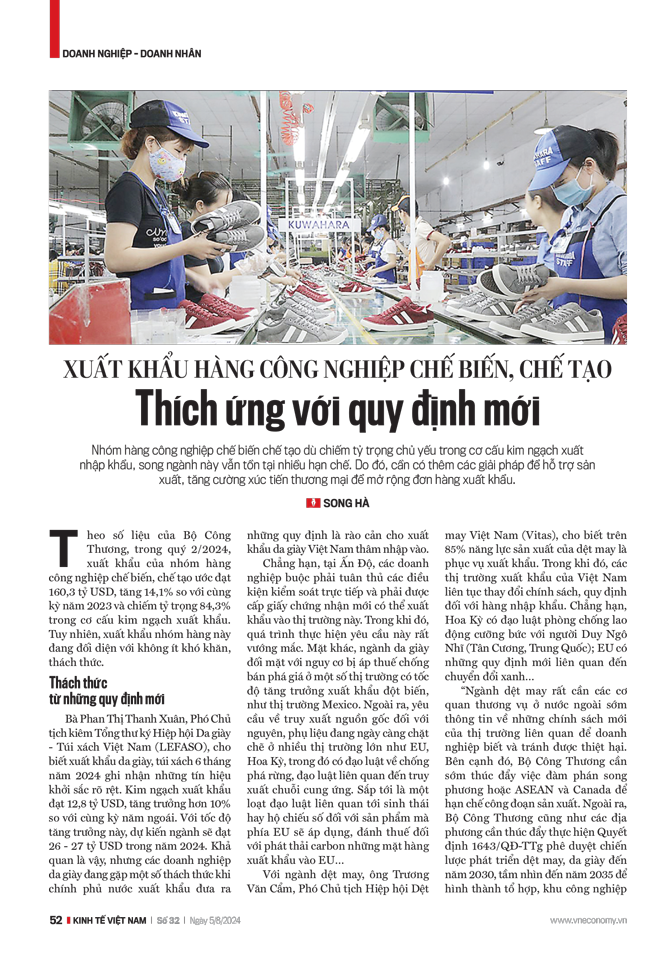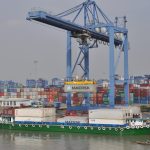According to the Ministry of Industry and Trade, in Q2/2024, exports of processed industrial goods are estimated to reach 160.3 billion USD, up 14.1% over the same period in 2023, accounting for 84.3% of export turnover.
CHALLENGES FROM NEW REGULATIONS
Ms. Phan Thi Thanh Xuan, Vice Chairman and General Secretary of the Vietnam Leather, Footwear and Handbag Association (LEFASO), said that leather and footwear exports in the first six months of 2024 showed positive signs of recovery. Export turnover reached 12.8 billion USD, growing by more than 10% compared to the same period last year. With this growth rate, the industry is expected to reach 26-27 billion USD in 2024. However, leather and footwear enterprises are facing some challenges as exporting countries impose regulations that hinder the penetration of Vietnamese leather and footwear products.
For example, in India, enterprises must comply with direct control conditions and obtain new certificates to export to this market. Meanwhile, the process of meeting this requirement is very cumbersome. On the other hand, the leather and footwear industry faces the risk of anti-dumping duties in some high-growth export markets, such as Mexico. In addition, the requirement for traceability of raw and auxiliary materials is becoming stricter in many large markets such as the EU and the US, including laws on anti-deforestation and those related to supply chain traceability. A series of laws related to ecology or digital passports for products that the EU will apply, and carbon emission taxes for exports to the EU…
In the textile and garment industry, Mr. Truong Van Cam, Vice Chairman of the Vietnam Textile and Apparel Association (VITAS), said that more than 85% of the textile and garment industry’s production capacity serves exports. Meanwhile, Vietnam’s export markets are constantly changing their policies and regulations on imported goods. For example, the US has the Uyghur Forced Labor Prevention Act (UFLPA) related to Xinjiang, China; the EU has new regulations related to the green transition…
“The textile and garment industry needs commercial offices abroad to promptly inform about the new policies of related markets to help businesses avoid damage. In addition, the Ministry of Industry and Trade should soon promote bilateral negotiations or between ASEAN and Canada to limit the production process.
In addition, the Ministry of Industry and Trade, as well as localities, should promote the implementation of Decision 1643/QD-TTg approving the development strategy of the textile, garment, and footwear industries by 2030, with a vision to 2035, to form textile and garment industrial complexes to produce raw and auxiliary materials to meet the export needs of the industry,” Mr. Cam suggested.
Similarly, in the supporting industry, Ms. Truong Thi Chi Binh, Secretary-General of the Vietnam Supporting Industries Association (VASI), said that besides price competition, enterprises in this industry are facing challenges from new market requirements, especially the requirement that input materials must be recycled. While recycled plastic and steel in Vietnam are extremely uncompetitive compared to China, as they cannot recover plastic from household and industrial sources to provide inputs for plastic recycling enterprises.
“The Association hopes that the Commercial Offices will share information and experiences in developed, developing, or similar markets to Vietnam that have done well in this regard for exports,” Ms. Binh suggested.
Ms. Binh said that supporting industry enterprises are capable of producing a diverse range of export products, such as motorcycle and bicycle components; products related to electrical cabinets and automation systems; plastics; rubber; plastic and rubber toys; fans, wind turbines…
PROMOTING EXPORT PROMOTION ACTIVITIES
Regarding the sharing of difficulties of industries, representatives of Vietnam’s Trade Offices abroad all assessed that besides the support of Trade Offices and Vietnamese embassies abroad, the role of enterprises is very important in promoting export promotion activities.
According to Mr. Do Ngoc Hung, Head of the Vietnam Trade Office in the US, besides the development of trade turnover between the two countries, the US is currently imposing many barriers on Vietnamese exporting enterprises, typically trade remedies through anti-dumping, anti-subsidy, and anti-evasion investigations. As of June 2024, the US is the country with the most trade remedy investigations on Vietnamese exports, with 11 cases. The number of lawsuits is expected to increase in the coming time.
For the textile and garment industry, to maintain its position as the second largest exporter (after China), Mr. Hung said that enterprises in this industry need to continue to pay attention to the US regulations on the Uyghur Forced Labor Prevention Act (UFLPA). At the same time, it is necessary to coordinate with the Ministry of Industry and Trade and the Trade Office to promptly reflect to the US Customs and Border Protection Agency to resolve shipments stopped at the border gate. Coordinate with the Trade Promotion Agency to actively and effectively participate in the International Textile and Garment and Leather and Footwear Fair (Magic Show) to be held in Las Vegas in the coming time.
Regarding electronic products and components, Mr. Hung said that Vietnamese enterprises need to pay attention in the process of cooperating with US partners because this country is actively implementing export control measures to limit the risk of these technologies and products falling into the hands of third parties.
Mr. Nguyen Phu Hoa, Commercial Counselor of Vietnam in Australia, said that processed and manufactured goods are always Vietnam’s key export items to Australia. In particular, four types of machinery, equipment, and spare parts; phones and components; computers, electronic products and components; vehicles and accessories accounted for 42% of Vietnam’s total export turnover to Australia in the first six months of 2024…
The article was published in the Vietnam Economic Magazine, Issue 32-2024, released on August 5, 2024. Please find the full article here:
https://postenp.phaha.vn/chi-tiet-toa-soan/tap-chi-kinh-te-viet-nam

Revolutionize Trade Promotion to Boost Exports “Beyond Barriers”
In 2024, the activities of export and import will still face numerous risks and uncertainties. Therefore, it is necessary to continue innovating and promoting the diversification and flexibility of various forms of trade promotion to expand into new export markets…
Thanh Hóa’s Foreign Affairs: Boosting Investment, Commerce, and Tourism
As part of the 2024 plan, the leaders of Thanh Hoa province will collaborate with international organizations, agencies, and businesses both within and outside the country to attract and promote investments. Additionally, the province will actively participate in major events to showcase and highlight the local potential and strengths in terms of investment, trade, and tourism…
Export revenue of 7 commodities exceeded 1 billion USD in January 2024.
The Ministry of Industry and Trade has reported that the export turnover of goods in January 2024 is estimated at $33.57 billion, representing a 6.7% increase compared to the previous month. In the face of unpredictable developments in the world, businesses need to be prepared to seize opportunities and be flexible in responding to challenges, in order to devise the most appropriate strategies.










































